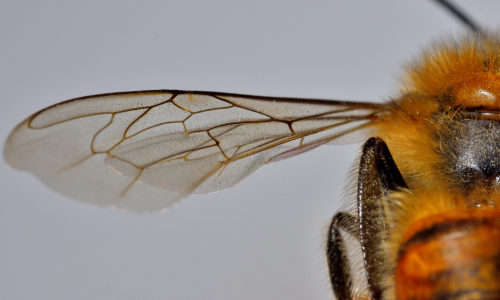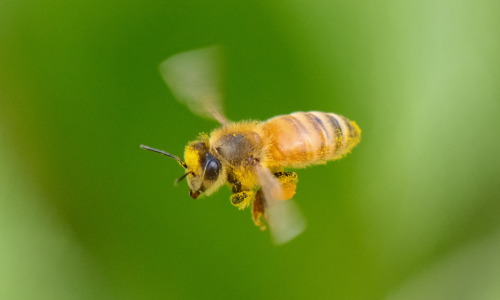In the intricate world of bees, wings serve far more purposes than just flight. At Dr. Killigan's, we're always in awe of nature's sophisticated designs, especially when it comes to these vital pollinators. Let's explore the multi-functionality of bee wings, uncovering 9 remarkable roles they play beyond mere mobility.
1. Anatomy and functionality
The familiar buzz you hear emanating from a bee is created by its wings, which beat at an incredible rate of 230 times per second. However, the marvel of bee flight extends beyond this rapid movement to the anatomical and functional design of their wings.
Bees are equipped with four wings: two larger forewings and two smaller hindwings. This unique quad-wing configuration plays a pivotal role in their survival, facilitating both transit from one flower to another and enabling a suite of aerodynamic feats. Through a sophisticated combination of twisting and swiveling, bee wings support precision flying, hovering and even the ability to fly backward. This intricate dance of movement showcases a level of aerial control that is unparalleled in the insect kingdom.
2. Structural marvels
At first glance, the delicate appearance of bee wings belies their true strength. These wings are marvels of natural engineering, designed to endure the rigors of a bee's busy life. The resilience of a bee wing is rooted in its sophisticated three-layered composition: two protective membranes sandwich a middle layer rich with hemolymph (bee blood) and nerves. This intricate structure ensures that bee wings can withstand significant impacts without damage.

Key to their durability is the presence of resilin within the wing joints—a highly elastic protein that lends remarkable flexibility, allowing wings to absorb and dissipate energy without tearing. This elasticity is crucial for the wide range of motions bee wings undergo during flight and other activities. However, this does not render the wings invincible; they can exhibit wear over time or be compromised by conditions such as the deformed wing virus, reflecting the balance between strength and vulnerability in the natural world.
Fun fact: Researchers estimate that bees get about 500 miles on their wings before they start to tear and wear out.
3. Nectar dehydration
Turning nectar into honey is a meticulous process involving dehydration. Bees play an active role in this by absorbing moisture from the nectar through their digestive systems. Once back at the hive, the nectar is transferred to the honeycomb cells. The real alchemy begins as bees fan their wings vigorously over the nectar-filled cells, a process that can last from a few hours to several days, depending on environmental conditions. This persistent fanning generates airflow within the hive, speeding up the evaporation of water from the nectar. Through this dedicated labor, the nectar gradually thickens into the honey we know and love. The transformation of nectar to honey is not only a testament to the bees' hard work but also their incredible ability to collaboratively regulate the hive's internal environment to produce this sweet treasure.
Fun fact: A worker bee can carry a load of nectar or pollen equal to 80% of her body weight.
4. Dance communication

Bees are celebrated for their 'waggle dance,' a sophisticated form of communication that guides fellow hive members to food sources. This dance, a blend of deliberate body movements, wing beats, and vibrations, encodes information about the location's distance and direction from the hive. This dance is even more remarkable because the bees use electroreception, an advanced sensory capability that allows them to detect and respond to electric fields. This ability is crucial for enhancing their navigation and foraging efficiency, as honeybees can sense electric fields emitted by nectar supplies through their antennae. This electric field sensitivity underpins the effectiveness of the waggle dance, allowing bees to communicate detailed information about the location of food sources.
Fun fact: Every species of bee performs its communication dances differently.
5. Ventilating the nest
The hive's air quality and temperature are vital to the bees' health and productivity. By meticulously using their wings to circulate air, bees ingeniously manage the hive's internal climate, expelling excess heat and carbon dioxide while introducing fresh oxygen. This natural ventilation system, essential for maintaining a balanced and comfortable environment, showcases the wings' multifunctional role beyond flight.
6. Temperature regulation
For bees to take flight, their flight muscles need to reach at least 86 degrees Fahrenheit, a temperature essential for the activation of their wing muscles. This warming up is achieved through rapid wing movement, akin to shivering in mammals, which generates the necessary heat for flight.
In hot conditions, bees can cool themselves down by spreading their wings and facilitating air circulation around their bodies, showcasing their impressive ability to regulate body temperature. This demonstrates remarkable thermoregulation abilities.
Fun fact: During the winter, some worker bees take on the job of “heater bees,” where they vibrate their bodies to keep the hive at the optimal temperature of 95ºF.
7. Coupling for flight

In a resting state, a bee's forewings rest atop its hindwings. However, when preparing for flight, the wings engage in a process known as 'wing coupling.' During this process, small hooks (hamuli) on the leading edge of the hindwings interlock with grooves on the trailing edge of the forewings. This ensures that the forewings and hindwings on each side of the bee's body function as a single, unified surface. This coupled movement significantly maximizes the surface area during flight, enabling greater lift and stability. Such mechanical interlocking is crucial for the bee's extensive range of aerial maneuvers, from precise hovering to long-distance foraging.
8. Queen and brood care
The queen's and her brood's well-being is paramount to the hive's survival, as the queen's prolific egg-laying ensures the colony's continuity. Bees ingeniously use their wings to generate warmth, creating a cozy incubator within the hive to maintain an optimal temperature for the queen to lay eggs and for the eggs to develop into healthy larvae. This thermogenic activity, akin to a natural heating system, is a communal effort that exemplifies the collaborative spirit of the hive and highlights how bee wings are crucial not just for flight but also for the survival and propagation of their species.
Fun fact: A productive queen can lay up to 2,500 eggs per day.
9. Survival in water
Although bees are not designed for aquatic environments, their ingenuity in survival tactics is evident when they encounter water. Utilizing their wings as hydrofoils—a concept in physics where structures are used to lift or maintain stability in water—they generate ripples, propelling themselves forward in a motion reminiscent of surfing. Hydrofoils create lift as they move through water, much like a surfboard catching a wave.
Safeguarding our shared environment
As we marvel at the remarkable intricacies of bee wings and their vital roles in our ecosystems, it becomes clear that protecting these magnificent creatures is not just an act of admiration—it's a necessity. Bees, with their aerodynamic mastery and sophisticated communication, underscore the delicate balance of nature that Dr. Killigan's is committed to preserving. Our approach goes beyond mere pest control; it's about fostering a healthy, sustainable environment where every living being, from the smallest bee to the families in your home, can thrive in harmony.

At Dr. Killigan's, we understand the importance of maintaining this balance, offering pest control solutions that are 100% non-toxic, 100% effective and 100% sophisticated. Our mission is to restore confidence, peace and control to every person who encounters unwanted pests in their home, all while keeping your family safe from pests and toxins. Our commitment is to continue innovating until household pests, unsafe toxins, and unsightly remedies are relics of the past.
We invite you to join us in this green revolution, where sophisticated science meets environmental stewardship. Visit Dr. Killigan's website today to learn more about our non-toxic pest control solutions and how you can contribute to a healthier, pest-free home and garden. Together, let's protect our shared environment and support the intricate dance of nature, ensuring a vibrant world for generations to come.





















